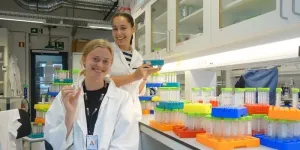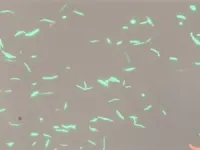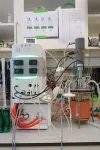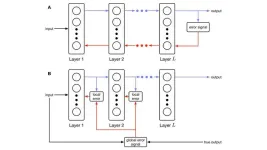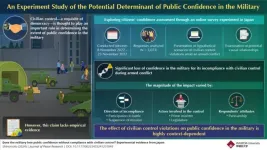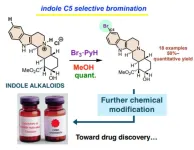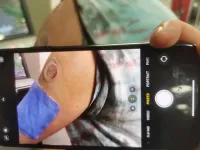(Press-News.org) When E. coli detects damage to its genetic material, it sends out an SOS signal that alters activity inside the cells.
“The bacteria go into full emergency mode,” says PhD candidate Olaug Elisabeth Torheim Bergum at the Norwegian University of Science and Technology (NTNU).
Imagine that you have a very sore throat. You're sick, your throat hurts, and a visit to the doctor confirms that the pain is due to a bacterial infection. You get a prescription for antibiotics, which quickly sorts out your sore throat. You are pleased that the treatment has worked – but how did the bacteria experience the situation?
“Antibiotic treatment causes damage to the bacteria. This damage can take the form of many different things, but it often involves damage to the genetic material, to the DNA, and activates an SOS response in the bacterium,” says Bergum, from the Department of Clinical and Molecular Medicine.
She has studied how the pathogenic bacterium Escherichia coli reacts when exposed to small, non-fatal amounts of the antibiotic Ciprofloxacin.
Ciprofloxacin is currently one of the most widely used antibiotics in the world, and works by attacking the DNA in the bacterial cells.
“It binds to a protein that helps maintain the proper structure of the DNA, by cutting and splicing the DNA strands. This is necessary because copying and reading DNA creates stress on the DNA molecule,” explains Bergum.
Initial repairs
In other words, the protein keeps the DNA strand in order while the bacterial cell carries on functioning. When the bacterium is about to divide, it ensures that DNA replication occurs in a safe and orderly manner. However, when the antibiotic binds to the protein, this function is prevented and things become rather chaotic.
Many common activities in the bacterium, such as replication, are put on hold. This is reflected in the bacteria changing shape.
“The DNA is then damaged, including the formation of single strands of incomplete DNA inside the cell,” says Bergum.
When these individual strands form, it's like lighting a match under a smoke detector. Other proteins detect the damaged DNA fragments and the alarm goes off. It's a dramatic situation for the bacterial cells, which can also be seen with the naked eye.
“It is all hands to the pumps. Many common activities in the bacterium, such as replication, are put on hold. This is reflected in the bacteria changing shape. Usually, E. coli bacteria are rod-shaped, but when exposed to Ciprofloxacin, they become long filaments. The bacteria prioritise repairing the damage.”
If they are unable to repair the damage flawlessly, they will move on to the next step.
“If the repairs are ineffective, the last resort is to alter the DNA. This is when they mutate. This response helps the bacteria to adapt and become resistant to antibiotics,” says Bergum.
You might also like: New method paves the way for new antibiotics
Developing resistance
Normally, a course of antibiotics will be given in such large doses that the damage to the DNA is too great to be repaired. However, at the Department of Clinical and Molecular Medicine at NTNU, researchers are interested in finding out what happens when bacteria actually win the fight against the antibiotic through their SOS response.
Knowing exactly how the repair processes and mutation take place is important in order to counteract antimicrobial resistance. Bergum and her colleagues have therefore chosen to look at both how the ‘SOS genes’ are activated and how the bacteria use proteins and small molecules to repair the damage caused by the antibiotic.
“When the alarm sounds, 60 different genes are activated inside the cell. It was previously thought that the genes are activated at different times, meaning the genes used to produce the proteins needed in the initial phase of repair work are activated first, and then the next set of genes are activated.”
However, the researchers at NTNU found that all the genes are activated at the same time.
“The regulation does not take place at the gene level, but at the protein level, and this is new knowledge,” says Bergum.
“Our results are different from those produced by other studies. This may be because we have grown the bacteria in a bioreactor, where we have complete control of the growth conditions. This gives us results that are easier to reproduce.”
Contributing to new medicines
The researchers have used methods where they can measure gene activation, proteins and small molecules.
“This study is the first to have looked at all three levels of the SOS response at the same time. We have also conducted frequent measurements, from one minute after the bacteria are exposed to antibiotics until two hours later. This provides a good understanding of the timeline,” says Bergum.
You might then think that preventing the development of resistance shouldn’t be a problem, as it only requires ensuring a large enough dose of the antibiotic. However, according to Bergum, it is not that simple.
“When treating an infection, not all bacteria will be exposed to the antibiotic to the same extent. This might be due to different uptake between different tissues and that some bacteria are naturally more resistant. Therefore, some of the bacteria can develop resistance.”
Bacteria can also develop resistance in nature.
By learning more about how the SOS response works, substances can be developed that attack these mechanisms.
“There are a lot of antibiotics in water and sewage, albeit in low doses. It is therefore important to reduce the use of antibiotics,” says Bergum.
The new insight into how the SOS response works will be useful in the development of new medicines.
“The world needs new antibiotics, and more knowledge about the mechanisms of resistance. By learning more about how the SOS response works, substances can be developed that attack these mechanisms. These substances, called inhibitors, can then be administered together with antibiotics like Ciprofloxacin to prevent the development of resistance,” says Bergum.
The study was part of the TAMIR project (Targeting antimicrobial resistance by inhibition of bacterial stress responses), led by Professor Marit Otterlei at NTNU. The work is funded by the Trond Mohn Foundation’s national research programme at AMR and NTNU.
Source:
Olaug Elisabeth Torheim Bergum et al.: Frontiers | SOS genes are rapidly induced while translesion synthesis polymerase activity is temporally regulated (frontiersin.org)
END
How E. coli defends itself against antibiotics
Antibiotics damage E. coli DNA, including by causing formation of single strands of incomplete DNA inside the cell. When that happens, it's like lighting a match under a smoke detector.
2024-06-20
ELSE PRESS RELEASES FROM THIS DATE:
Mental health leaders to gather for international summit on suicide prevention
2024-06-20
DETROIT (June 20, 2024)— Mental health experts from across the globe will gather to share insights, best practices, and innovations for preventing suicide during the 5th Zero Suicide International Summit June 24-25 in Liverpool, England.
Named for the innovative, evidence-based suicide intervention model developed at Henry Ford Health, the Zero Suicide International Summit is presented by the Detroit-based healthcare system in partnership with Zero Suicide Alliance (ZSA) and The Kevin and Margaret Hines Foundation.
The Zero Suicide model was developed at Henry Ford Health in 2001. Within a year of implementing the ...
Can AI learn like us?
2024-06-20
It reads. It talks. It collates mountains of data and recommends business decisions. Today’s artificial intelligence might seem more human than ever. However, AI still has several critical shortcomings.
“As impressive as ChatGPT and all these current AI technologies are, in terms of interacting with the physical world, they’re still very limited. Even in things they do, like solve math problems and write essays, they take billions and billions of training examples before they can do them well, " explains Cold Spring Harbor Laboratory (CSHL) NeuroAI Scholar Kyle Daruwalla.
Daruwalla ...
Changing climate will make home feel like somewhere else
2024-06-20
Changing climate will make home feel like somewhere else
Interactive app shows how climate change will make places around the world feel like they are closer to the equator
FROSTBURG, MD (June 20, 2024)—The impacts of climate change are being felt all over the world, but how will it impact how your hometown feels? An interactive web application from the University of Maryland Center for Environmental Science allows users to search 40,581 places and 5,323 metro areas around the globe to match the expected future climate in each city with the current climate of another location, ...
Newly discovered dinosaur boasts big, blade-like horns
2024-06-20
What do you get when you cross Norse mythology with a 78-million-year-old ancestor to the Triceratops? Answer: Lokiceratops rangiformis, a plant-eating dinosaur with a very fancy set of horns.
The new dinosaur was identified and named by Colorado State University affiliate faculty member Joseph Sertich and University of Utah Professor Mark Loewen. The dinosaur’s name, announced today in the scientific journal PeerJ, translates roughly to “Loki’s horned face that looks like a caribou.”
Loewen and Sertich, co-lead authors of the PeerJ study, dubbed the new species Lokiceratops (lo-Kee-sare-a-tops) ...
Exploring the relationship between civilians and military organizations through an experiment in Japan
2024-06-20
In democracies where civilian control is followed, the power to make crucial decisions, like those of national security, is mainly exercised by elected officials, allowing the citizens who elect them to influence such decisions indirectly. This role can give people a sense of participation in matters of national importance, potentially associated with their political trust. The military, in such cases, advises and helps these elected leaders in serving the nation, rather than assuming leadership itself. A balance between civilians and military organizations is, therefore, crucial for any democracy to thrive, and it is pointed out that civilian control is a requisite of democracy.
Existing ...
A simple, fast, and versatile method for selective bromination of indole alkaloids
2024-06-20
Indolo[2,3-a]quinolizidine is a common structural motif in various natural products. Its molecular structure contains the indole ring, a functional group in tryptophan. Tryptophan, an essential amino acid, is required for the production and maintenance of our body’s proteins, muscles, enzymes, and neurotransmitters. Many natural products are derived from it. Over 3,000 monoterpene indole alkaloids (MTIAs), which are natural products consisting of indole rings, have been found in plants, and some of them have been used as medicines. For example, vinblastine has been used as an anticancer drug, and reserpine is used to treat high blood pressure.
The ...
Removal of ovaries before menopause associated with reduced white matter in brain
2024-06-20
WINSTON-SALEM, N.C. – June 20, 2024 – Women who have their ovaries removed before menopause, particularly before the age of 40, have reduced white matter integrity in multiple regions of the brain later in life. White matter refers to the nerve fibers that connect neurons in different areas of the brain.
The findings appear online today in Alzheimer’s & Dementia: The Journal of the Alzheimer’s Association.
“We know that having both ovaries removed before natural menopause causes abrupt endocrine dysfunction, which increases ...
Fewer good gut bacteria increase the risk of serious infection
2024-06-20
The composition of the intestinal flora can predict the chances of developing serious infections such as pneumonia. Researchers from Amsterdam UMC and the University of Turku, Finland, followed more than 10,000 people for 6 years. More than 600 people who had less healthy intestinal flora developed a serious infection, with this leading in some cases to death. The results of the study are published today in The Lancet Microbe.
The 602 people who were hospitalised due to an infection showed at the start of the study that they had fewer butyrate-producing ...
Sweat health monitor measures levels of disease markers
2024-06-20
PULLMAN, Wash. -- A wearable health monitor developed by Washington State University researchers can reliably measure levels of important biochemicals in sweat during physical exercise.
The 3D-printed monitor could someday provide a simple and non-invasive way to track health conditions and diagnose common diseases, such as diabetes, gout, kidney disease or heart disease.
Reporting in the journal, ACS Sensors, the researchers were able to accurately monitor the levels of volunteers’ glucose, lactate ...
Scientists devise algorithm to engineer improved enzymes
2024-06-20
Scientists have prototyped a new method for “rationally engineering” enzymes to deliver improved performance. They have devised an algorithm, which takes into account an enzyme’s evolutionary history, to flag where mutations could be introduced with a high likelihood of delivering functional improvements.
Their work – published today in leading journal Nature Communications – could have significant, wide-ranging impacts across a suite of industries, from food production to human ...
LAST 30 PRESS RELEASES:
UCLA study links scar healing to dangerous placenta condition
CHANGE-seq-BE finds off-target changes in the genome from base editors
The Journal of Nuclear Medicine Ahead-of-Print Tip Sheet: January 2, 2026
Delayed or absent first dose of measles, mumps, and rubella vaccination
Trends in US preterm birth rates by household income and race and ethnicity
Study identifies potential biomarker linked to progression and brain inflammation in multiple sclerosis
Many mothers in Norway do not show up for postnatal check-ups
Researchers want to find out why quick clay is so unstable
Superradiant spins show teamwork at the quantum scale
Cleveland Clinic Research links tumor bacteria to immunotherapy resistance in head and neck cancer
First Editorial of 2026: Resisting AI slop
Joint ground- and space-based observations reveal Saturn-mass rogue planet
Inheritable genetic variant offers protection against blood cancer risk and progression
Pigs settled Pacific islands alongside early human voyagers
A Coral reef’s daily pulse reshapes microbes in surrounding waters
EAST Tokamak experiments exceed plasma density limit, offering new approach to fusion ignition
Groundbreaking discovery reveals Africa’s oldest cremation pyre and complex ritual practices
First breathing ‘lung-on-chip’ developed using genetically identical cells
How people moved pigs across the Pacific
Interaction of climate change and human activity and its impact on plant diversity in Qinghai-Tibet plateau
From addressing uncertainty to national strategy: an interpretation of Professor Lim Siong Guan’s views
Clinical trials on AI language model use in digestive healthcare
Scientists improve robotic visual–inertial trajectory localization accuracy using cross-modal interaction and selection techniques
Correlation between cancer cachexia and immune-related adverse events in HCC
Human adipose tissue: a new source for functional organoids
Metro lines double as freight highways during off-peak hours, Beijing study shows
Biomedical functions and applications of nanomaterials in tumor diagnosis and treatment: perspectives from ophthalmic oncology
3D imaging unveils how passivation improves perovskite solar cell performance
Enriching framework Al sites in 8-membered rings of Cu-SSZ-39 zeolite to enhance low-temperature ammonia selective catalytic reduction performance
AI-powered RNA drug development: a new frontier in therapeutics
[Press-News.org] How E. coli defends itself against antibioticsAntibiotics damage E. coli DNA, including by causing formation of single strands of incomplete DNA inside the cell. When that happens, it's like lighting a match under a smoke detector.
